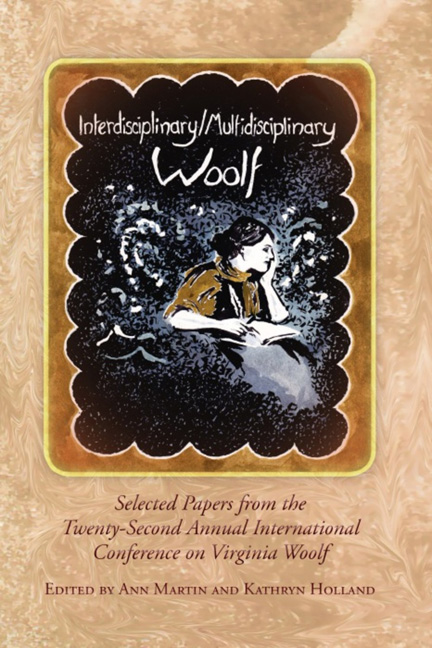Book contents
- Frontmatter
- Contents
- Introduction to Interdisciplinary/Multidisciplinary Woolf
- Acknowledgments
- List of Abbreviations
- History, Materiality, Multiplicity
- Patterns, Practices, Principles
- “Waving to Virginia”
- Woolf, Defoe, Derrida: Interdisciplinary dogs—or the canine aesthetics and (gender) politics of creativity
- “The law is on the side of the normal”: Virginia Woolf as Crip Theorist
- A Healing Centre of One's Own: Woolf's Legacy and Public Responses to Child Abuse
- Sunflower Suture: Disseminating the Garden in The Years
- “One Must Be Scientific”: Natural History and Ecology in Mrs. Dalloway
- Clarissa's Glacial Skepticism: John Tyndall and “Deep Time” in Mrs. Dalloway
- Apollonian Illusion and Dionysian Truth in Mrs. Dalloway
- Art, Influence, Embodiment
- Publishing, Politics, Publics
- Notes on Contributors
- Conference Program
Woolf, Defoe, Derrida: Interdisciplinary dogs—or the canine aesthetics and (gender) politics of creativity
from Patterns, Practices, Principles
- Frontmatter
- Contents
- Introduction to Interdisciplinary/Multidisciplinary Woolf
- Acknowledgments
- List of Abbreviations
- History, Materiality, Multiplicity
- Patterns, Practices, Principles
- “Waving to Virginia”
- Woolf, Defoe, Derrida: Interdisciplinary dogs—or the canine aesthetics and (gender) politics of creativity
- “The law is on the side of the normal”: Virginia Woolf as Crip Theorist
- A Healing Centre of One's Own: Woolf's Legacy and Public Responses to Child Abuse
- Sunflower Suture: Disseminating the Garden in The Years
- “One Must Be Scientific”: Natural History and Ecology in Mrs. Dalloway
- Clarissa's Glacial Skepticism: John Tyndall and “Deep Time” in Mrs. Dalloway
- Apollonian Illusion and Dionysian Truth in Mrs. Dalloway
- Art, Influence, Embodiment
- Publishing, Politics, Publics
- Notes on Contributors
- Conference Program
Summary
My current work, Virginia Woolf and the Signifying Dog, tracks the shifting canine tropes underpinning Woolf's writings in numerous genres on multiple disciplines. Woolf's mercurial dog figure is a sliding signifier representing the historic, unequal struggles between men and women over artistic subjectivity, authority, and voice in verbal, visual, musical, and theatrical arts. For example, in the finale to the multidisciplinary pageant, in Between the Acts, the megaphonic voice urges the audience, fragmentarily mirrored back to themselves, to “Consider the dogs [who] do openly what we do slyly” (BTA 134). Woolf's signifying dogs intervene at the intersection between art and life, between artists and their subjects, between art and audience, between art and criticism, and between the arts themselves. What might be at stake, artistically, politically, and ethically, in the tricks performed by this evolving troupe of interdisciplinary dogs? One thing at stake I suggest is the as such of dasein where, according to Heidegger and others, the caesura falls between animal and man, the site of violence and creativity in all its multiplicities.
The “ironic apparatus” of the “anthropological machine,” according to Giorgio Agamben, installs a shifting caesura in the narrative of the historical “passage from animal to man” where or when an animal-not-yet-human births a human-animal, and where the acquisition of language is a key indicator of that passage from animality to humanity (Agamben 37). In patriarchy, we might add, the “passage from animal to man,” where or when an animal-not-yet-human births a human-animal, occurs every time a mother whelps a son!
The verb “whelp” serves my dogged interests here precisely because of its canine provenance. As the OED shows whelp is both noun and verb, the noun applicable to “the young of various animals” and humans, but distinctively canine in pedigree and often derogatory. The transitive verb, “whelp,” means of a bitch dog “To bring forth” or to give birth to “(a whelp or whelps)”; it may also serve intransitively meaning to “bring forth whelps” and again slides toward the derogatory. It has an “uncertain” etymology. Is it perhaps related to that other rare transitive birth verb “to world”?
- Type
- Chapter
- Information
- Interdisciplinary/Multidisciplinary Woolf , pp. 95 - 101Publisher: Liverpool University PressPrint publication year: 2013



